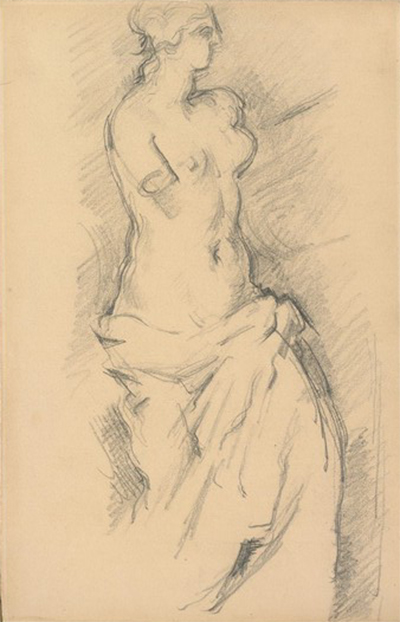 Buy Art Prints Now
Buy Art Prints Nowfrom Amazon
* As an Amazon Associate, and partner with Google Adsense and Ezoic, I earn from qualifying purchases.
Cezanne liked to study sculpture from time to time, travelling to the Louvre in Paris in order to witness some of the best examples in this genre. He would develop his skills as a draughtsman by capturing some of his favourite sculptures with strokes of graphite, as found here in this study of Venus de Milo.
Venus de Milo is an ancient Greek statue from between 130 and 100 BC. It is generally regarded as one of the most famous sculptures in history and certainly a highlight from past civilisations. It retains a prominent position today within the collection of the Louvre in Paris, even encouraging a spoof version from the Spanish surrealist artist, Salvador Dali, which became known as Venus de Milo with Drawers. Dali himself would regularly take classic art and produce his own versions of it, normally as a sign of respect rather than attempting to mock the original piece in any way. Aside from this, many art students would have entered the halls of the Louvre for the same purposes as Cezanne, as in to sketch and study the contours of these remarkable sculptures. To consider how old they are, it seems extraordinary that such a piece from those civilisations could have been so impressively constructed and also in such good condition all these centuries later.
The full length sculpture features a female figure in marble with both arms missing and her bottom half covered in some sort of dress or robe. The artist has been identified as Alexandros of Antioch. One can see from Cezanne's drawing only her right side, where the arm continues down to around what we today term the t-shirt length. Her other arm is shortened even more than this, but is hidden by the torso in this drawing because of the angle from which Cezanne chooses to work. We see her face in side profile, though he does not implement too much detail upon it. He is light with his touch of graphite, though adding darker contours around the edges of the figure. A light, loose tone is then used around the background to help the figure stand out from the unused parts of the paper.
This sketch was just one of around seventy artworks within a single sketchbook that Cezanne would take with him on various trips. He loved to work without planning ahead, just whenever the urge struck him. That said, this trip to the Louvre was obviously made with the intention of working in this way, where as his time in the countryside were more ad-hoc in terms of choosing when and what to sketch. In many cases he would later use these studies to produce fuller paintings, but would not always do so. We did see Still Life with Cherub, which appears to have been a painted version of a sculpture, but this was a rare addition to his career and normally he only used sculpture as a means to developing his talents as a draughtsman.



